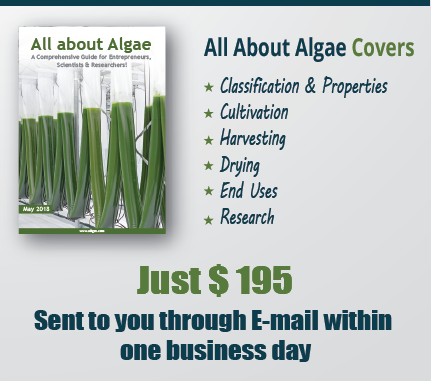Use of algae, especially the cyanobacteria (blue-green algae), for antibiotics and pharmacologically active compounds has received ever increasing interest. There are a range of pharmaceutical products derived from algae. Some of them include:
|
Antimicrobials, Antivirals & Antifungals Neuroprotective Products Therapeutic proteins Drugs |
1. Antimicrobials, Antivirals & Antifungals
Both Microalgae and macroalgae exhibit antimicrobial activity which finds use in various pharmaceutical industries.
Role of Microalgae
§ Microalgae, such as Ochromonas sp., Prymnesiumand a number of blue Green algae produce toxins that may have potential pharmaceutical applications (Katircioglu et al, 2006)
§ Various strains of Cyanobacteria are known to produce intracellular and extracellular metabolites with diverse biological activities such as antibacterial, antifungal and antiviral activity (Naoman et al,2004)
§ The biological activities of the algae may be attributed to the presence of volatile compounds, some phenols, free fatty acids and their oxidized derivatives (Zornitsa et al, 2009)
Role of macroalgae
§ There are numerous reports of macroalgae derived compounds that have a broad range of biological activities, such as antibiotic, antiviral, anti- neoplastic, antifouling, anti-inflammatory, cytotoxic and antimitotic (Naqvi et al., 1980)
§ In the past few decades, macroalgae have been widely recognised as producers of a broad range of bioactive metabolites (Caccamese et al., 1981)
§ Such antimicrobial properties enable macroalgae to be used as natural preservatives in the cosmetic industry.
§ The highest percentage of antimicrobial activity was found in Phaeophyceae (84%), followed by Rhodophyceae (67%) and Chlorophyceae (44%). (Noemi et al, 2007)
§ Red and brown macroalgae extracts show significant potential as anti-pathogenic agents for use in fish aquaculture. (Wefky et al, 2008)
2. Neuroprotective Products
Both microalgae and macroalgae are neuroprotective agents and promote nerve cell survival.
Role of microalgae
Among the various microalgal species, Spirulina is most commonly referred as a neuroprotective agent
§ Spirulina platensis may be useful in the development of novel treatments for neurodegenerative disorders such as Alzheimers or Parkinson diseases.
§ Spirulina maxima is found to partially prevent MPTP (1-methyl-4-phenyl-1,2,3,6 tetrahydropyridine) neurotoxicity and oxidative stress, suggesting it could be a possible alternative in experimental therapy.
Role of macroalgae
§ Several macroalgae are found to possess therapeutic potential for combating neurodegenerative diseases associated with neuroinflammation.
§ A marine macroalgae, Ulva conglobata, a marine algae, has neuroprotective effects in murine hippocampal and microglial cellshttp://bit.ly/9Iu2P9
3. Human Therapeutic Proteins
Pharmaceutical companies could substantially reduce the expense of costly treatments for cancer and other diseases produced from mammalian or bacterial cells by growing human therapeutic proteins in algae. Microalgae usually find extensive use as therapeutic and diagnostic proteins.
Role of microalgae
§ Expression of recombinant proteins in green algal chloroplast holds substantial promise as a platform for the production of human therapeutic proteins
§ The percentage of human proteins produced in their algal cultures is comparable to the fraction produced by mammalian cell cultures and much better than that produced by bacterial systems
§ A study confirmed that diverse human therapeutic proteins could be produced in Chlamydomonas reinhardtii, a green alga
§ Algae can be used to produce
VEGF (Vascular Endothelial Growth Factor) for treating emphysema
HMGB1 (High Moblility Group Protein B1) which activates immune cells
Domain 14 of human fibronectin
Domain 10 of human fibronectin used to increase the accumulation of other proteins
Human proinsulin could be produced by algae, but only at lower levels
The costs of using algae at large scale to commercially produce human proteins should be much lower than for mammalian cell culture, which require expensive Fermentation facilities
4. Drugs
Algal chemistry has interested many researchers in order to develop new drugs, as algae include compounds with functional groups which are characteristic from this particular source.
Role of microalgae
§ Researchers have been able to produce an exciting class of anti-cancer drugs originally isolated from blue-green algae
§ A compound named cryptophycin 1 has been isolated from blue-green algae which hold significant promise as an anti-cancer drug
§ Microalgae produce incredibly potent alkaloidal neurotoxins such as saxitoxin and polyketide neurotoxins such as the brevetoxins for use as anticancer drugs.
§ Role of macroalgae
§ The alkaloids found in marine macroalgae present special interest because of their pharmacological activities.
§ These alkaloids in macroalgae are largely focused on finding drugs for cancer treatment.
Companies Deriving Pharmaceutical Products from Algae
|
Rincon Pharmaceuticals www.rinconpharma.com/ Rallis http://www.rallis.co.in/ Monsanto http://www.monsanto.com/default.asp Jubilant Organosys http://www.jubl.com/ Piramal Healthcare http://www.piramalhealthcare.com/ AstraZeneca http://www.astrazenecaindia.com/ Idec Pharmaceuticals www.idecpharm.com National Facility for Marine Cyanobacteria http://www.nfmc.res.in/ Novo Nordisk India Private Ltd http://www.novonordisk.co.in/documents/home_page/document/index.asp Agri Life SOM Phytopharma (India) Limited http://www.somphyto.com/ Labprocure India Pvt Ltd http://www.pharmaceuticals1.com/organisation/labprocure-ind-pvt-ltd.html
|
|
The following table lists various algae used in medicine and their respective uses (Reference: Compendium of Materia Medica): |
||||||||||||||||||||||||||||||||||||||||||||||
|
||||||||||||||||||||||||||||||||||||||||||||||
|
|
|
Click Here to Know More |
|
|
Poly unsaturated fatty acids(DHA,ARA,GAL and EPA) Aquaculture Feed (Shrimp feed, Shellfish Feed, Marine Fish Larve cultivation ) |
|



